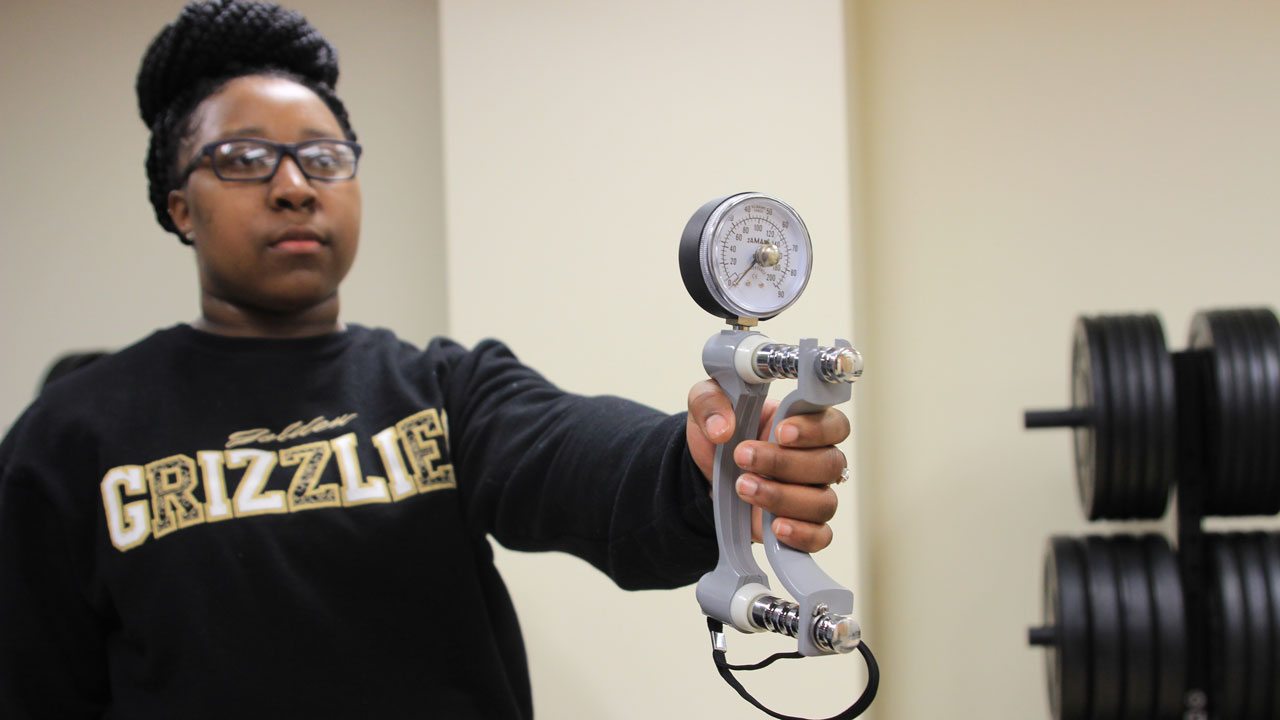- YouTube
- TikTok
OU researchers establish grip strength cut points to assess diabetes risk
Their research study is published in the American Journal of Preventive Medicine and is designed to help diagnose diabetes early, when it is most treatable

Exercise science major Artishia Moore demonstrates the use of a handgrip dynamometer, a device that measures grip strength.

What can a person’s grip strength reveal about their health?
Research studies have linked low muscular strength to increased risk for type 2 diabetes, a chronic condition that impairs the body’s response to insulin, resulting in high blood sugar and paving the way for further health challenges.
“Insulin is mainly responsible for helping to clear nutrients out of the bloodstream and into various tissues, including muscle tissue,” said Elise Brown, assistant professor of wellness and health promotion. “When there’s issues with insulin resistance – which we find in diabetes – the body is not as effective in driving those nutrients, including protein, into the skeletal muscles. And that is part of what we think contributes to lower muscle mass and associated lower muscular strength in type 2 diabetes.”
Elise Brown |
Brown is the lead author on a new research study published in the American Journal of Preventive Medicine that establishes grip strength cut points to assess diabetes risk in apparently healthy U.S. adults. The cut points are adjusted for weight, age and gender and are designed to help diagnose diabetes early, when it is most treatable.
“Type 2 diabetes is reversible if it’s caught soon enough,” said Brown. “The grip strength cut points provide a simple way to assess diabetes risk using a handgrip dynamometer, a device that’s low-cost, easy to be trained on and transportable as well.”
The dynamometer measures grip strength in pounds or kilograms of force. When a person’s grip strength is below the cut point for their gender, weight and age group, they may be at increased risk for type 2 diabetes and recommended for further diagnostic tests.
The study analyzed data from the National Health and Nutrition Examination Survey and was the first grip strength analysis focused exclusively on diabetes screening for apparently healthy U.S. adults.
“We excluded people from our sample who had heart disease, cancer or stroke, which are comorbidities associated with diabetes,” Brown explained. “That allowed us to more accurately screen for diabetes specifically.”
According to the Centers for Disease Control, one in 10 Americans has diabetes, with 90-95 percent of the cases being type 2. Additionally, one out of every three Americans has prediabetes, meaning their blood sugar levels are higher than normal and could develop into diabetes. The CDC reports that the percentage of adults with prediabetes who were aware they had the condition doubled between 2005 and 2016.
Unfortunately, most people at risk for diabetes continue to be unaware, which makes them vulnerable to serious health complications.
“High blood sugar damages blood vessels, which can lead to heart disease, vision loss, kidney failure and other problems,” said Brown. “The longer a person goes without diagnosis and intervention, the greater their risk for complications.”
Along with health risks, the costs associated with treating diabetes and prediabetes are immense. The total economic burden was estimated to be more than $400 billion in 2017.
Brown and others are working to reverse these trends by providing easier access to screening tools.
“We’re trying to figure out how to improve the health of our communities,” said Brown. “One way we can do that is through grip strength cut points that help address the risk and economic burden of type 2 diabetes.”
The grip strength study was funded through an Oakland University Research Committee Summer Fellowship. Along with Brown, OU collaborators included Dorin Drignei, a professor in the Department of Mathematics and Statistics, and students Breanne Gordon (health sciences) and Samar Madi (mathematics and statistics).


 April 6, 2020
April 6, 2020